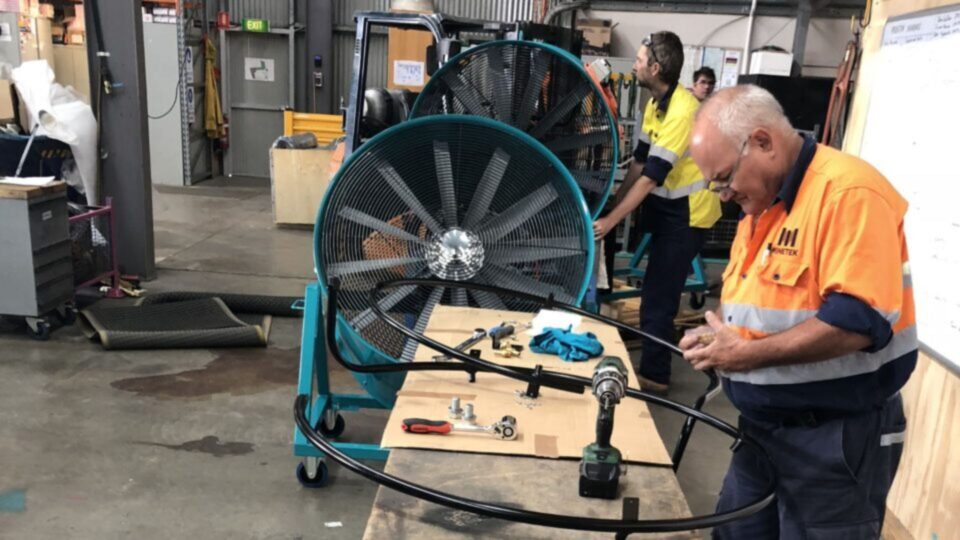According to Occupational Health and Safety representatives, workers’ environments should be between 18 and 23 degrees Celsius.
If you’re operating a manufacturing facility, it can reach incredibly high temperatures during summer – especially with equipment and machinery being operated in the space.
Keep reading as we explore how to keep a manufacturing facility cool in summer – ensuring your workers are healthy and content in your workplace.
Causes of heat in a manufacturing facility.
What are the main contributors to overheating in the manufacturing industry in Australia? Let’s discuss:
- Poor ventilation and air circulation – circulating the air and providing ventilation ensures that hot air won’t pool around the equipment and machinery in a manufacturing facility.
- Heat generation – manufacturing processes, especially those using methods like boiling and smelting, can cause heat to disperse into the surrounding air.
- Poor insulation – An inadequately insulated facility will experience more heat due to external heat sources.
To manage these heat causes, it is essential to consider Cooling Fans for summer and other heat management strategies.
Methods for managing heat in a manufacturing facility
Here’s how you can control heat in a manufacturing facility to improve productivity and keep workers comfortable.
Install high volume low speed (HVLS) fans.
High-volume and low-speed fans are designed to move large volumes of air at a low speed – preventing large gusts of air that could interfere with manufacturing processes. An industrial HVLS fan such as a Giant Fan helps to reduce stagnant pockets of hot air and regulate temperature distribution.
Roof colour.
If your roof material is a dark colour, it will draw in heat from the sun. Painting your roof in a lighter colour or switching out the material for that of a lighter colour will help reduce heat absorption, reflecting the sunlight instead. Changing the colour will reduce heat buildup and lower the need for excessive cooling.
Insulate your building, piping, and equipment.
Proper insulation will help minimise heat transfer between the inside and outside of the building. You should invest in roof, wall, floor, and piping insulation to prevent heat from escaping or entering the facility. You might also insulate the machinery and equipment in your facility to reduce the amount of heat radiating into the atmosphere.
Practice preventative maintenance.
When equipment isn’t properly maintained, it can cause increased friction and energy usage – leading to increased heat production. By practicing preventative maintenance, you can prevent overheating issues, which could lead to elevated temperatures in the manufacturing facility.
Invest in zip doors.
Zip doors, also known as high-speed roll-up doors and strip curtains, create a physical barrier between areas within the facility and reduce energy wastage. The doors contain heat within different areas of the facility.
Shift your operational hours.
Ensure your operational hours are aligned with the cooler parts of the day. Ensure that hotter manufacturing processes take place in the morning or late in the evening. This will decrease the overall heat production.
Top cooling solutions for manufacturing facilities.
Here are the top ventilation solutions to help with heat destratification and dissipation within a manufacturing facility.
- Giant Fans – a Giant Fan is capable of producing a substantial airflow volume to reduce stagnant heat pockets. Fanquip Giant Fans are available with diameters ranging between 7 and 24 feet, capable of cooling large-scale manufacturing facilities with a consistent and gentle airflow.
- Mancoolers – a Mancooler is designed to provide localised cooling for equipment in a manufacturing facility. It typically has a stand or wheels, making it maneuverable. A Mobile Mancooler is perfect for portability and maneuverability across large-scale manufacturing facilities.
- Air Circulators – an Air Circulator helps to improve overall air circulation within a space by moving air across large areas whilst also distributing both heat and cool air evenly. It reduces stagnant air pockets to improve temperature regulation.
Choosing the right cooling solution for your facility will depend on the facility size and the airflow exchange rate requirements for your industry.
Choose Fanquip for manufacturing cooling solutions.
When the summer months arrive, keep your workers cool with proper ventilation and heat management strategies.
Are you planning your ventilation strategy? Fanquip’s ventilation experts can help you to develop a manufacturing ventilation strategy that aligns with industry specifications.
